Shungura Formation
The Shungura Formation is a stratigraphic formation located in the Omo river basin in Ethiopia. It dates to the Late Pliocene to Early Pleistocene. Oldowan tools have been found in the formation, suggesting early use of stone tools by hominins. Among many others, fossils of Panthera were found in Member G of the formation.[1][2]
| Shungura Formation | |
|---|---|
| Stratigraphic range: Piacenzian-Gelasian | |
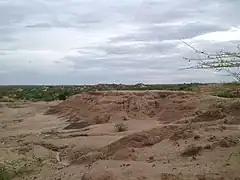 Lower Omo Valley | |
| Type | Geological formation |
| Unit of | Omo Group |
| Underlies | Kalam Formation |
| Overlies | Mursi Formation |
| Lithology | |
| Primary | Sandstone, siltstone |
| Other | Claystone, tuff |
| Location | |
| Coordinates | 5.1°N 36.0°E |
| Approximate paleocoordinates | 5.8°N 36.1°E |
| Country | |
| Extent | Omo Subbasin Turkana Basin |
 Shungura Formation (Ethiopia) | |
Geology
The formation comprises sandstones, siltstones, claystones and tuff, deposited in a fluvial to deltaic lacustrine environment.
Paleobiota
Fossil content
Color key
|
Notes Uncertain or tentative taxa are in small text; |
Among many others, the following fossils have been reported from the formation:[3][4][5][6][7][8][9][10][11]
Chiroptera
| Bats of the Shungura Formation | |||||
|---|---|---|---|---|---|
| Taxa | Species | Locality | Material | Notes | Images |
| Hipposideros | H. kaumbului | Member F. | A Roundleaf bat. | ||
| Taphozous | T. abitus | Member F. | Extinct relative of tomb bats and sheath-tailed bats. | ||
Lagomorphs
| Lagomorphs of the Shungura Formation | ||||||
|---|---|---|---|---|---|---|
| Taxa | Species | Locality | Material | Notes | Images | |
| Lepus | L. capensis | Member E, and lower Members F and G. | ||||
Eulipotyphla
| Eulipotyphlas of the Shungura Formation | |||||
|---|---|---|---|---|---|
| Taxa | Species | Locality | Material | Notes | Images |
| Crocidura | C. aithiops | ||||
| Suncus | S. haesaertsi | ||||
| S. cf. lixus | |||||
| S. shungurensis | |||||
Perissodactyls
- Chalicotheres
| Chalicotheres of the Shungura Formation | ||||||
|---|---|---|---|---|---|---|
| Taxa | Species | Locality | Material | Notes | Images | |
| Ancylotherium | A. hennigi[12] | Members D and G. [12] | A chalicothere. | |||
- Rhinocerotidae
| Rhinocerotidaes of the Shungura Formation | ||||||
|---|---|---|---|---|---|---|
| Taxa | Species | Locality | Material | Notes | Images | |
| Ceratotherium | C. simum | Members C, D, E, J, K, L, and O. | A white rhinoceros. | |||
| Diceros | D. bicornis | Members B, D, L, K, and O. | Complete Skull and Molars. | A black rhinoceros. | ||
- Equidae
| Equids of the Shungura Formation | ||||||
|---|---|---|---|---|---|---|
| Taxa | Species | Locality | Material | Notes | Images | |
| Equus | E. oldowayensis[13] | Members F, G, H, I, and J. | Jawbone mandible with complete dentition. | An Olduvai zebra. | ||
| Eurygnathohippus | E. libycum | Members C, E, F, G, and L. | A Hipparionine horse. | |||
| Hipparion | H. sitifense[14] | Members A, B, C, D, E, F, and G | Multiple cheek teeth and fragmented dentition. | Relatives of early horses. | ||
Rodents
| Rodents of the Shungura Formation | ||||||
|---|---|---|---|---|---|---|
| Taxa | Species | Locality | Material | Notes | Images | |
| Aethomys | A. deheinzelini | a rock mouse. | ||||
| Arvicanthis | A. sp. | |||||
| Acomys | A. sp. | |||||
| Gerbillus | G. sp. | |||||
| Heterocephalus | H. atikoi | |||||
| Jaculus | J. orientalis | |||||
| Mastomys | M. minor | |||||
| Paraxerus | P. ochraceus | |||||
| Pelomys | P. sp. | |||||
| Saidomys | S. sp. | |||||
| Tatera | T. sp. | |||||
| Xerus | X. sp. | |||||
Bovids
| Bovids of the Shungura Formation | ||||||
|---|---|---|---|---|---|---|
| Taxa | Species | Locality | Material | Notes | Images | |
| Aepyceros | A. shungurae | Members B, C, D, E, F, and G | Extinct relative of modern impala. | |||
| Antidorcas | A. recki | Members B, C, D, E, F, G, and H. | Extinct relative of modern springbok | |||
| Beatragus | B. antiquus | Member G. | Extinct relative of modern Hirola. | |||
| Gazella | G. praethomsoni | Members F, G, and H. | ||||
| Kobus | K. ancystrocera | Member B, C, E, G, and J. | ||||
| K. ellipsiprymnus | Member G, J, and K. | A waterbuck. | ||||
| K. oricornis | Extinct relatives of the Kobus family. | |||||
| K. sigmoidalis | Members D, E, F, and G. | |||||
| Megalotragus | M. sp. | An alcelaphine. | ||||
| Menelikia | M. lyrocera | Members C, E, F, G, H, I, and J. | ||||
| Pelorovis | P. sp. | |||||
| Parmularius | P. altidens | Members G and H. | ||||
| Redunca | R. sp. | A reedbuck. | ||||
| Syncerus | S. cf. acoelotus | Members B, C, D, E, F, and G. | ||||
| Tragelaphus | T. gaudryi | |||||
| T. nakuae | ||||||
Camelids
| Camels of the Shungura Formation | |||||
|---|---|---|---|---|---|
| Taxa | Species | Locality | Material | Notes | Images |
| Camelus | C. grattardi[15] | Lower member G (G4-G13). | Distal humerus L1–68–76, maxilla fragment with heavily worn P4–M2 (Omo 75S-70–956); same individual as Omo 75–69–2222, M3. | Extinct relative of Camels. | |
| Camelus | C. sp. | ||||
Giraffidae
| Giraffids of the Shungura Formation | ||||||
|---|---|---|---|---|---|---|
| Taxa | Species | Locality | Material | Notes | Images | |
| Giraffa | G. gracilis | Members E and F | ||||
| G. pygmaea | Members G. | |||||
| G. jumae | ||||||
| Sivatherium | S. maurusium | Member F. | ||||
Hippopotamidae
| Hippopotamids of the Shungura Formation | ||||||
|---|---|---|---|---|---|---|
| Taxa | Species | Locality | Material | Notes | Images | |
| Hexaprotodon | H. protoamphibius | |||||
| H. shungurensis | ||||||
| Hippopotamus | H. protoamphibius | |||||
Suidae
| Suidae of the Shungura Formation | |||||
|---|---|---|---|---|---|
| Taxa | Species | Locality | Material | Notes | Images |
| Kolpochoerus | K. limnetes | An omnivorous pig. | 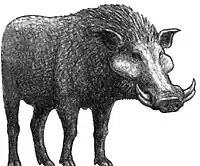 | ||
| Metridiochoerus | M. jacksoni | A giant warthog. | 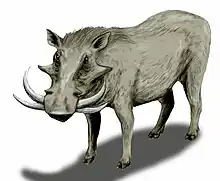 | ||
| M. modestus | |||||
| Notochoerus | N. euilus | ||||
| N. scotti[16] | |||||
| Nyanzachoerus | N. kanamensis | ||||
Carnivora
| Carnivorans of the Shungura Formation | ||||||
|---|---|---|---|---|---|---|
| Taxa | Species | Locality | Material | Notes | Images | |
| Enhydriodon | E. omoensis[17] | Right femur (L 183-14), fragmented mandible, and lower dentition. | A lion-sized river otter. | 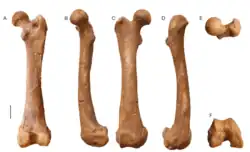 Enhydriodon omoensis right femur faced at different sides. | ||
| Dinofelis | D. petteri | Member A, B, C, D, E, F, and G. [18] | Damaged cranium skull and dentition fragments, OMO 1-768-3.[18] | A sabertooth cat. | ||
| D. sp.[18] | Member A, B, C, D, E, F, and G. [18] | Postcranial skulls (OMO 28-67-1075 from Member B), craniodental, and dentition fragments.[18] | ||||
| Helogale | H. hirtula | Extinct species of Mongoose family. | ||||
| H. kitafe | ||||||
| Homotherium | H. aethiopicum | |||||
Hyracoidea
| Hyraxes of the Shungura Formation | |||||
|---|---|---|---|---|---|
| Taxa | Species | Locality | Material | Notes | Images |
| Gigantohyrax | G. maguirei[19] | A giant hyrax. | |||
Proboscideans
| Proboscideans of the Shungura Formation | |||||
|---|---|---|---|---|---|
| Taxa | Species | Locality | Material | Notes | Images |
| Loxodonta | L. adaurora | Extinct subspecies of African elephants. | |||
| L. exoptata | |||||
| Palaeoloxodon recki | P. r. shungurensis | An extinct elephant species native to Africa. | 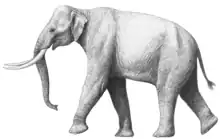 Life restoration of Palaeoloxodon recki | ||
Cercopithecidae
| Cercopithecids of the Shungura Formation | |||||
|---|---|---|---|---|---|
| Taxa | Species | Locality | Material | Notes | Images |
| Dinopithecus | D. sp.[20][21] | ||||
| Paracolobus | P. mutiwa[21] | Member C, E, and G. [22] | |||
| Rhinocolobus | R. turkanaensis[21] | Member C, E, and G.[22] | |||
| Theropithecus | T. brumpti | Members B, C, D, E, F, and G. | Extinct relative of Gelada Baboons. | ||
| T. oswaldi | Members D, E, F, G, H, I, J, K, and L. | ||||
Galagidae
| Galagidaes of the Shungura Formation | |||||
|---|---|---|---|---|---|
| Taxa | Species | Locality | Material | Notes | Images |
| Otolemur | O. howelli | Member B. | L. 1-378 (right m2), L. 1-377 (holotype, left maxillary fragment) with P4-M1, and Omo 229-73-4018 (right mandibular fragment).[23] | Extinct relative of greater galago. | |
Hominins
| Homonids of the Shungura Formation | |||||
|---|---|---|---|---|---|
| Taxa | Species | Locality | Material | Notes | Images |
| Australopithecus | A. sp. | ||||
| Paranthropus | P. aethiopicus | Members C, D, E, and F. | |||
| P. boisei | Members G and K. | ||||
Reptiles
| Reptiles of the Shungura Formation | ||||||
|---|---|---|---|---|---|---|
| Taxa | Species | Locality | Material | Notes | Images | |
| Euthecodon[24] | E. brumpti | Member H. | Complete partial skull. | A giant African long-snouted crocodile, formally named Tomistoma brumpti. | ||
Fish
| Fish of the Shungura Formation | ||||||
|---|---|---|---|---|---|---|
| Taxa | Species | Locality | Material | Notes | Images | |
| Auchenoglanis | A. sp. | Members F3 and G24. | Omo 199 1973-1278 and Omo 215 1973-2556, two pectoral spines, the former lacking the distalmost tip. | |||
| Clarias | C. sp. | |||||
| Gymnarchus | G. sp. | |||||
| Polypterus | P. bichir | An association of several rows of rhombic ganoid scales, Omo 40-4343. | A Nile Bichir. |  | ||
| Sindacharax | S. greenwoodi | Relatives of African tetras. | ||||
| S. omoensis | Upper Member A. | Omo 128-72-22, Partial premaxilla (right) broken off lateral to the third outer tooth and second inner tooth, with first and second inner teeth in situ, and tooth bases visible of the first, second, and third outer teeth. | ||||
| Synodontis | S. frontosus | relatives of Mochokid catfishes | ||||
| S. schall | ||||||
See also
References
- Sabol, 2011, p.230
- Boaz, N. T., Howell, F. C., & McCrossin, M. L. (1982). Faunal age of the Usno, Shungura B and Hadar Formations, Ethiopia. Nature, 300(5893), 633–635. https://doi.org/10.1038/300633A0
- ETE Locality 807, Omo - member G at Fossilworks.org
- ETE Locality 860, Omo - member C at Fossilworks.org
- ETE Locality 486, Omo - O.75 at Fossilworks.org
- ETE Locality 452, Omo - O.81, P.928 at Fossilworks.org
- ETE Locality 363, Omo - L.28 at Fossilworks.org
- ETE Locality 835, Omo - member G5 at Fossilworks.org
- Stewart, Kathlyn & Murray, Alison. (2008). Fish remains from the Plio-Pleistocene Shungura Formation, Omo River basin, Ethiopia. Geobios - GEOBIOS-LYON. 41. 283-295. 10.1016/j.geobios.2007.06.004.
- Boaz, N. T., Howell, F. C., & McCrossin, M. L. (1982). Faunal age of the Usno, Shungura B and Hadar Formations, Ethiopia. Nature, 300(5893), 633–635. https://doi.org/10.1038/300633A0
- Sillen, A. (1986). Biogenic and Diagenetic Sr/Ca in Plio-Pleistocene Fossils of the Omo Shungura Formation. Paleobiology, 12(3), 311–323. http://www.jstor.org/stable/2400437
- Denis Geraads. Faunal Change in Eastern Africa at the Oldowan – Acheulean Transition. The Emergence of the Acheulean in East Africa and Beyond: Contributions in Honor of Jean Chavaillon, In press. ffhalshs-01819105
- Gilbert, William & Bernor, Raymond. (2009). Equidae. 10.1525/california/9780520251205.003.0006.
- Eisenmann, Véra. (1976). Equidae from the Shungura formation. Earliest Man and Environments in the Lake Rudolf Basin. 225-233.
- John Rowan, Pietro Martini, Likius Andossa, Gildas Merceron, Jean-Renaud Boisserie. New Pliocene remains of Camelus grattardi (Mammalia, Camelidae) from the Shungura Formation, Lower Omo Valley, Ethiopia, and the evolution of African camels. Historical Biology, 2018, 31 (9), pp.1123-1134. ⟨10.1080/08912963.2017.1423485⟩. ⟨hal-02100346⟩
- White, T. D., & Suwa, G. (2004). A New Species of Notochoerus (Artiodactyla, Suidae) from the Pliocene of Ethiopia. Journal of Vertebrate Paleontology, 24(2), 474–480. http://www.jstor.org/stable/4524733
- Grohé, Camille & Uno, Kevin & Boisserie, Jean-Renaud. (2022). Lutrinae Bonaparte, 1838 (Carnivora, Mustelidae) from the Plio-Pleistocene of the Lower Omo Valley, southwestern Ethiopia: systematics and new insights into the paleoecology and paleobiogeography of the Turkana otters. 21. 681-705. 10.5852/cr-palevol2022v21a30.
- Werdelin, Lars & Lewis, Margaret. (2001). A revision of the genus Dinofelis (Mammalia, Felidae). Zoological Journal of the Linnean Society. 132. 147 - 258. 10.1111/j.1096-3642.2001.tb02465.x.
- Skinner, J. D.; Chimimba, Christian T. (2005). The Mammals of the Southern African Sub-region. Cambridge University Press. p. 41. ISBN 9781107394056. Retrieved 20 September 2022.
- Jablonski, Nina & Leakey, Meave & Anton, Mauricio. (2008). Systematic paleontology of the cercopithecines. The Fossil Monkeys. 6. 103-300.
- Gilbert, C. C. (2013). Cladistic analysis of extant and fossil African papionins using craniodental data. Journal of Human Evolution, 64(5), 399–433. https://doi.org/10.1016/J.JHEVOL.2013.01.013
- Pallas, L., Daver, G., Merceron, G., & Boisserie, J. (2023, February 3). Postcranial anatomy of colobines (Mammalia, Primates) from the Plio-Pleistocene Omo Group deposits (Shungura Formation and Usno Formation, 1967-2018 field campaigns, Lower Omo Valley, Ethiopia). https://doi.org/10.31233/osf.io/bwegt
- Werdelin, Lars & Partridge, Timothy & Seiffert, Erik & Feakins, Sarah & Demenocal, Peter & Jacobs, Bonnie & Gunnell, Gregg & Holroyd, Patricia & Asher, Robert & Sanders, William & Rasmussen, David & Gutiérrez, Mercedes & Domning, Daryl & Winkler, Alisa & Avery, D. Margaret & Godinot, Marc & Harrison, Terry & Godfrey, Laurie & Jablonski, Nina & Cerling, Thure. (2010). Cenozoic Mammals of Africa. 10.1525/california/9780520257214.001.0001. Page: 344-345
- Joleaud ML (1920) On the presence of a Gavialide of the genus Tomistoma in the freshwater Pliocene of Ethiopia, Comptes Rendus de l'Académie des Sciences 70, 816-818
Bibliography
- Sabol, Martin. 2011. Masters of the lost world: a hypothetical look at the temporal and spatial distribution of lion-like felids. Quaternaire 4. 229–236. Accessed 2018-09-02.
Further reading
- L. Bobe and M. Mabela. 1997. Incidence of four gastrointestinal parasite worms in the group of cricetomas, Lukaya-Democratic Republic of Congo. Tropicultura 15(3):132-135
- C. S. Churcher and D. A. Hooijer. 1980. The Olduvai Zebra (Equus oldowayensis) from the later Omo beds, Ethiopia. Zoologische Mededelingen 55(22):265-280
- Y. Coppens and F. C. Howell. 1985. Les Faunes Plio-Pleistocenes de las Basse Vallee de l'Omo (Ethiopie), Tome 1: Perissodactyls, Artiodactyls (Bovidae). Cahiers de Paleontologie, Editions du CNRS, Paris
- G. Eck. 1977. Diversity and frequency distributions of Omo Group Cercopithecidae. Journal of Human Evolution 6:55-63
- C. S. Feibel, F.H. Brown, and I. McDougall. 1989. Stratigraphic Context of Fossil hominids from the Omo Group Deposits: Northern Turkana Basin, Kenya and Ethiopia. American Journal of Physical Anthropology 78:595-622
- J. de Heinzelin. 1983. The Omo Group: Archives of the International Omo Research Expedition. Musee Royal de l'Afrique Centrale, Annales Series 8, Tervuren, Belgique 85
- F. C. Howell and Y. Coppens. 1973. Inventory of remains of Hominidae from Pliocene and Pleistocene formations of the lower Omo Basin, Ethiopia (1967-1972). American Journal of Physical Anthropology 40:1-16
- M. G. Leakey. 1982. Extinct large Colobines from the Plio-Pleistocene of Africa. American Journal of Physical Anthropology 58:153-172
- 2015 - Thomas W. Plummer, Joseph V. Ferraro, Julien Louys, Fritz Hertel, Zeresenay Alemseged, René Bobe, L. C. Bishop - Bovid ecomorphology and hominin paleoenvironments of the Shungura Formation, lower Omo River Valley, Ethiopia
- 1979 - Robert J. Rogers & Francis H. Brown - Authigenic mitridatite from the Shungura Formation, southwestern Ethiopia
- G. Suwa, T. D. White, and F. Clark Howell. 1996. Mandibular postcanine dentition from the Shungura Formation, Ethiopia: Crown morphology, taxonomic allocations and Plio-Pleistocene Hominid Evolution. American Journal of Physical Anthropology 101:247-282
- Vickers-Rich, Patricia & Rich, Thomas Hewett (1993); Wildlife of Gondwana. Reed. ISBN 0-7301-0315-3
- H. B. Wesselman. 1984. The Omo Micromammals: Systematics and Paleoecology of Early Man Sites from Ethiopia. Contributions to Vertebrate Evolution 17
This article is issued from Wikipedia. The text is licensed under Creative Commons - Attribution - Sharealike. Additional terms may apply for the media files.